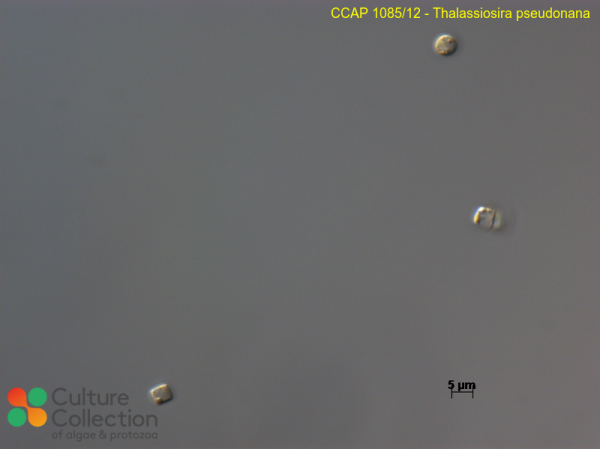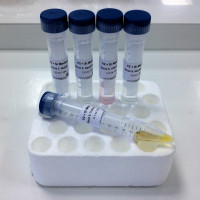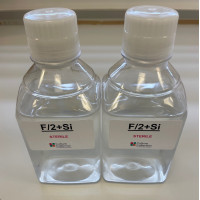References [ 51 ]
Gachon CMM, Day JG, Campbell CN, Pröschold T, Saxon RJ & Küpper FC (2007) The Culture Collection of Algae and Protozoa (CCAP): A biological resource for protistan genomics Gene 406: 51-57.
Amin SA, Green DH, Hart MC, Küpper FC, Sunda WG & Carrano CJ (2009) Photolysis of iron-siderophore chelates promotes bacterial-algal mutualism. PNAS 106(40): 17071-17076.
Flors C, Fryer MJ, Waring J, Reeder B, Bechtold U, Mullineaux PM, Nonell S, Wilson MT & Baker NR (2006) Imaging the production of singlet oxygen in vivo using a new fluorescent sensor, Singlet Oxygen Sensor Green ® Journal of Experimental Botany 57: 1725-1734.
Hatton AD & Wilson ST (2007) Particulate dimethylsulphoxide and dimethylsulphoniopropionate in phytoplankton cultures and Scottish coastal waters. Aquatic Sciences - Research Across Boundaries 69: 330-340.
Thamatrakoln K, Alverson AJ & Hildebrand M (2006) Comparative sequence analysis of diatom silicon transporters: Toward a mechanistic model of silicon transport. Journal of Phycology 42: 822-834.
Scheffel A, Poulsen N, Shian S & Kroger N (2011) Nanopatterned protein microrings from a diatom that direct silica morphogenesis. PNAS 108: 3175-3180.
Damsté JSS, Muyzer G, Abbas B, Rampen SW, Massé G, Allard WG, Belt ST, Robert JM, Rowland SJ, Moldowan JM, Barbanti SM, Fago FJ, Denisevich P, Dahl J, Trindade LA & Schouten S (2004) The rise of the rhizosolenid diatoms. Science 304 (5670): 584-587.
Baker KM, Gobler CJ & Collier JL (2009) Urease gene sequences from algae and heterotrophic bacteria in axenic and nonaxenic phytoplankton cultures. Journal of Phycology 45: 625-634.
Theriot EC, Ashworth M, Ruck E, Nakov T & Jansen RK (2010) A preliminary multigene phylogeny of the diatoms (Bacillariophyta): Challenges for future research. Plant Ecology and Evolution 143: 278-296.
Wilson ST (2007) The production of biogenic gases in the marine environment. A Thesis presented for the degree of Doctor of Philosophy at the Open University -: 319 pp.
DOI: none
Armbrust EV & Galindo HM (2001) Rapid evolution of a sexual reproduction gene in centric diatoms of the genus Thalassiosira Applied and Environmental Microbiology 67: 3501-3513.
Volkman JK, Jeffrey SW, Nichols PD, Rogers GI & Garland CD (1989) Fatty acid and lipid composition of 10 species of microalgae used in mariculture Journal of Experimental Marine Biology and Ecology 128: 219-240.
DOI: none
Tonon T, Harvey D, Qing R, Li Y, Larson TR & Graham IA (2004) Identification of a fatty acid 11-desaturase from the microalga Thalassiosira pseudonana FEBS Letters 563: 28-34.
Liu Z, Lee C & Wakeham SG (2006) Effects of mercuric chloride and protease inhibitors on degradation of particulate organic matter from the diatom Thalassiosira pseudonana Organic Geochemistry 37: 1003-1018.
Yu ET, Zendejas FJ, Lane PD, Gaucher S, Simmons BA & Lane TW (2009) Triacylglycerol accumulation and profiling in the model diatoms Thalassiosira pseudonana and Phaeodactylum tricornutum (Baccilariophyceae) during starvation Journal of Applied Phycology 21: 669-681.
Hildebrand M, Frigeri LG & Davis AK (2007) Synchronized growth of Thalassiosira pseudonana (Bacillariophyceae) provides novel insights into cell-wall synthesis processes in relation to the cell cycle Journal of Phycology 43: 730-740.
Carvalho RN, Burchardt AD, Sena F, Mariani G, Mueller A, Bopp SK, Umlauf G & Lettieri T (2011) Gene biomarkers in diatom Thalassiosira pseudonana exposed to polycyclic aromatic hydrocarbons from contaminated marine surface sediments Aquatic Toxicology 101: 244-253.
Hildebrand M, Kim S, Shi D, Scott K & Subramaniam S (2009) 3D imaging of diatoms with ion-abrasion scanning electron microscopy Journal of Structural Biology 166: 316-328.
Alverson AJ, Beszteri B, Julius ML & Theriot EC (2011) The model marine diatom Thalassiosira pseudonana likely descended from a freshwater ancestor in the genus Cyclotella BMC Evolutionary Biology 11: 125.
DOI: none
Lommer M, Specht M, Roy A, Kraemer L, Andreson R, Gutowska MA, Wolf J, Bergner SV, Schilhabel MB, Klostermeier UC, Beiko RG, Rosenstiel P, Hippler M & LaRoche J (2012) Genome and low-iron response of an oceanic diatom adapted to chronic iron limitation. Genome Biology 13: R66.
Maberly SC, Courcelle C, Groben R & Gontero B (2010) Phylogenetically-based variation in the regulation of the Calvin cycle enzymes, phophoribulokinase and glyceraldehyde-3-phosphate dehydrogenase, in algae. Journal of Experimental Botany 61: 735-745.
Thamatrakoln K & Hildebrand M (2008) Silicon uptake in diatoms revisited: A model for saturable and nonsaturable uptake kinetics and the role of silicon transporters. Plant Physiology 146: 1397-1407.
Roleda MY, Slocombe SP, Leakey RJG, Day JG, Bell EM & Stanley MS (2013) Effects of temperature and nutrient regimes on biomass and lipid production by six oleaginous microalgae in batch culture employing a two-phase cultivation strategy. Bioresource Technology 129: 439-449.
Waring J, Klenell M, Bechtold U, Underwood GJC & Baker NR (2010) Light-induced responses of oxygen photoreduction, reactive oxygen species production and scavenging in two diatom species. Journal of Phycology 46: 1206-1217.
Vlachakis D, Pavlopoulou A, Kazazi D & Kossida S (2013) Unraveling microalgal molecular interactions using evolutionary and structural bioinformatics. Gene 528: 109-119.
Zhuang Y, Zhang H & Lin S (2013) Polyadenylation of 18S rRNA in algae Journal of Phycology 49: 570-579.
Qian D, Jiang L, Lu L, Wei C & Li Y (2011) Biochemical and structural properties of cyanases from Arabidopsis thaliana and Oryza sativa. PLoS ONE 6(3): e18300.
Boyd PW, Rynearson TA, Armstrong EA, Fu F, Hayashi K, Hu Z, Hutchins DA, Kudela RM, Litchman E, Mulholland MR, Passow U, Strzepek RF, Whittaker KA, Yu E & Thomas MK (2013) Marine phytoplankton temperature versus growth responses from polar to tropical waters - outcome of a scientific community-wide study. PLoS ONE 8(5): e63091.
Tsaousis AD, Gentekaki E, Eme L, Gaston D & Roger AJ (2014) Evolution of the cytosolic iron-sulfur cluster assembly machinery in Blastocystis species and other microbial eukaryotes. Eukaryotic Cell 13: 143-153.
Day JG, Burt DJ, Achilles-Day UEM & Stanley MS (2013) Future algal biofuels: Implications of environmental temperature on production strain selection. International Journal of Ambient Energy 36: 248-252.
Slocombe SP, Zhang QY, Ross M, Anderson A, Thomas NJ, Lapresa A, Rad Menéndez C, Campbell CN, Black KD, Stanley MS & Day JG (2015) Unlocking nature's treasure-chest: Screening for oleaginous algae. Scientific Reports 5: 09844.
Rad Menéndez C, Stanley M, Green DH, Cox EJ & Day JG (2015) Exploring cryptic diversity in publicly available strains of the model diatom Thalassiosira pseudonana (Bacillariophyceae). Journal of the Marine Biological Association of the UK 95: 1081-1090.
Laohavisit A, Anderson A, Bombelli P, Jacobs M, Howe CJ, Davies JM & Smith AG (2015) Enhancing plasma membrane NADPH oxidase activity increases current output by diatoms in biophotovoltaic devices Algal Research 12: 91-98.
Clement R, Dimnet L, Maberly SC & Gontero B (2015) The nature of the CO2-concentrating mechanisms in a marine diatom, Thalassiosira pseudonana. New Phytologist 209: 1417-1427.
Bailleul B, Berne N, Murik O, Petroutsos D, Prihoda J, Tanaka A, Villanova V, Bligny R, Flori S, Falconet D, Krieger-Liszkay A, Santabarbara S, Rappaport F, Joliot P, Tirichine L, Falkowski PG, Cardol P, Bowler C & Finazzi G (2015) Energetic coupling between plastids and mitochondria drives CO2 assimilation in diatoms. Nature 524: 366.
Lis H, Shaked Y, Kranzler C, Keren N & Morel FMM (2015) Iron bioavailability to phytoplankton: An empirical approach. The ISME Journal 9: 1003-1013.
Sjollema SB, Redondo-Hasselerharm P, Leslie HA, Kraak MHS & Vethaak AD (2016) Do plastic particles affect microalgal photosynthesis and growth? Aquatic Toxicology 170: 259-261.
Canavate JP, Armada I, Ríos JL & Hachero-Cruzado I (2016) Exploring occurrence and molecular diversity of betaine lipids across taxonomy of marine microalgae. Phytochemistry 124: 68-78.
Li G, Talmy D & Campbell DA (2016) Diatom growth responses to photoperiod and light are predictable from diel reductant generation. Journal of Phycology 53: 95-107.
Murphy CD, Ni G, Li G, Barnett A, Xu K, Grant-Burt J, Liefer JD, Suggett DJ & Campbell DA (2017) Quantitating active photosystem II reaction center content from fluorescence induction transients Limnology and Oceanography Methods 15: 54-69.
Po BHK, Ho KL, Lam MHW, Giesy JP & Chiu JMY (2017) Uptake and biotransformation of 2,2′,4,4′-tetrabromodiphenyl ether (BDE-47) in four marine microalgae species. Scientific Reports 7: 44263.
Clement R, Lignon S, Mansuelle P, Jensen E, Pophillat M, Lebrun R, Denis Y, Puppo C, Maberly SC & Gontero B (2017) Responses of the marine diatom Thalassiosira pseudonana to changes in CO2 concentration: a proteomic approach. Scientific Reports 7: 42333.
Schaller-Laudel S, Latowski D, Jemiola-Rzeminska M, Strzalka K, Daum S, Bacia K, Wilhelm C & Goss R (2017) Influence of thylakoid membrane lipids on the structure of aggregated light-harvesting complexes of the diatom Thalassiosira pseudonana and the green alga Mantoniella squamata Physiologia Plantarum -: -.
Brembu T, Skogen Chauton M, Winge P, Bones AM & Vadstein O (2017) Dynamic responses to silicon in Thalasiossira pseudonana - Identification, characterisation and classification of signature genes and their corresponding protein motifs Scientific Reports 7: 4865.
Schaum CE, Buckling A, Smirnoff N, Studholme DJ & Yvon-Durocher G (2018) Environmental fluctuations accelerate molecular evolution of thermal tolerance in a marine diatom. Nature Communications 9: 1719.
Clement R, Jensen E, Prioretti L, Maberly S & Gontero B (2017) Diversity of CO2-concentrating mechanisms and responses to CO2 concentration in marine and freshwater diatoms Journal of Experimental Botany 68: 3925-3935.
Schaum CE (2018) Enhanced biofilm formation aids adaptation to extreme warming and environmental instability in the diatom Thalassiosira pseudonana and its associated bacteria Limnology and Oceanography -: -.
Grant SD, Richford K, Burdett HL, McKee D & Patton BR (2020) Low-cost, open-access quantitative phase imaging of algal cells using the transport of intensity equation Royal Society Open Science 7: -.
McLeod AR, Brand T, Campbell CN, Davidson K & Hatton A (2021) Ultraviolet radiation drives emission of climate-relevant gases from marine phytoplankton. Journal of Geophysical Research: Biogeosciences 126: 9.
Alcaraz-Rocha P, Puig-Fàbregas J, Garrido JL & Sobrino C (2023) Ocean acidification affects pigment concentration and photoprotection of marine phytoplankton. Limnology and Oceanography 68(4): 831-844.
Kim SY, Rasmussen U & Rydberg S (2024) Impact of the neurotoxin β-N-methylamino-L-alanine on the diatom Thalassiosira pseudonana using metabolomics Marine Pollution Bulletin 202: 116299.




